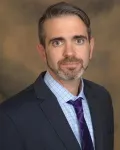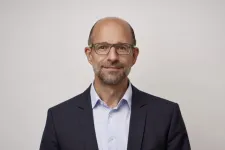(Press-News.org) Researchers at the Texas A&M School of Veterinary Medicine and Biomedical Sciences (VMBS) have uncovered how natural selection “rewilds” domestic rabbits.
The study, published in Nature Ecology and Evolution, helps answer the question of how normally tame rabbits — which have many natural predators — can become a force of ecological destruction when purposefully or accidentally reintroduced to the wild.
Here Comes Peter Cottontail
Every gardener knows how much of a nuisance rabbits can be, but many people may not realize the magnitude of ecological destruction that rabbits are capable of.
“The classic example is Australia, which was colonized by rabbits to the point that it caused one of the largest environmental disasters in history,” said Dr. Leif Andersson, a professor in the VMBS’ Department of Veterinary Integrative Biosciences and a professor at Uppsala University in Sweden. “In 1859, an Englishman named Thomas Austin released 24 European rabbits onto his estate as game animals, but the population of rabbits exploded, causing an infestation that continues to cause millions of dollars’ worth of crop damage each year.
“What is interesting is that rabbits had already been introduced to Australia in 1788. Why did Austin’s rabbit release cause such a population explosion and not the earlier release?” he said.
Thanks to the recent study, scientists now believe that they have the answer.
“After sequencing the genomes of nearly 300 rabbits from Europe, South America, and Oceania, we found that all of them had a mix of feral and domestic DNA,” Andersson said. “This was not what we had expected to find — we expected that feral rabbits were domestic rabbits that have somehow relearned how to live in the wild. But our findings show us that these rabbits already had a portion of wild DNA helping them survive in nature.”
Andersson’s discovery explains why the 24 rabbits introduced to the Australian landscape in 1859 were so quick to adapt to living in the wild — they already possessed the right genetic traits that would help them thrive.
Rewilding Domestic Rabbits
But returning a species to the wild after centuries of domestication isn’t a simple process. For example, domestic rabbits have been bred by humans to be more docile and trusting than their wild counterparts. They are also often bred to have certain coat colors that humans find attractive — like all-black or all-white coats — that would make them easier for predators to spot in the wild.
“During the rewilding process, natural selection removes many of these domestic traits because they are maladaptive — or unhelpful for survival — in the wild,” Andersson explained. “But it’s not just coat colors that change. We also observed that many of the genetic variants removed during natural selection are related to behavior, like tameness. This brings back the wild flight instinct that is important for eluding predators.”
The entire process appears to depend on whether the rabbits already have wild genes in their DNA as a sort of foundation for the rewilding process.
“We hope that this study will help lawmakers understand the importance of preventing domestic animals from being released into the wild,” Andersson said. “This project has helped us understand not only how rabbits become feral but also how other species like pigs and cats can become feral nuisances.”
The study is a collaboration with the Research Center in Biodiversity and Genetic Resources (CIBIO), a Portuguese research organization.
By Courtney Price, Texas A&M University School of Veterinary Medicine and Biomedical Sciences
###
END
Texas A&M research collaboration uncovers how domestic rabbits become feral in the wild
2024-07-12
ELSE PRESS RELEASES FROM THIS DATE:
Scientists find new way global air churn makes particles
2024-07-12
By Leah Shaffer
You can think of our atmosphere as a big chemistry set, a global churn of gaseous molecules and particles that constantly bounce off and change each other in complicated ways. While the particles are very small, often less than 1% of the thickness of human hair, they have outsized impacts. For example, particles are the seeds of cloud droplets, and the abundance of the particles changes the reflectivity and the amount of clouds, rainfall and climate.
Now, researchers at Washington University in St. ...
Researchers discover a new neural biomarker for OCD
2024-07-12
A recent study from Baylor College of Medicine and Texas Children’s Hospital has identified a specific neural activity pattern as a novel biomarker to accurately predict and monitor the clinical status of individuals with obsessive-compulsive disorder (OCD) who have undergone deep brain stimulation (DBS), a rapidly emerging therapeutic approach for severe psychiatric disorders. The study, led by led by Drs. Sameer Sheth and Wayne Goodman along with co-lead authors, Drs. Nicole Provenza, ...
Vivid portrait of interacting galaxies marks Webb’s second anniversary
2024-07-12
Two for two! A duo of interacting galaxies commemorates the second science anniversary of NASA’s James Webb Space Telescope, which takes constant observations, including images and highly detailed data known as spectra. Its operations have led to a “parade” of discoveries by astronomers around the world.
“Since President Biden and Vice President Harris unveiled the first image from the James Webb Space Telescope two years ago, Webb has continued to unlock the mysteries of the universe,” said NASA Administrator Bill Nelson. “With remarkable images from the ...
UMass Amherst awarded $2.1 million to advance the science of engagement in community-academic research partnerships
2024-07-12
University of Massachusetts Amherst researcher Thomas Mackie has received a $2.1 million funding award from the Patient-Centered Outcomes Research Institute (PCORI) to advance the meaningful engagement of communities that are affected by mental health disparities and underrepresented in research partnerships.
The study, entitled “Improving Research Partnership With Engagement Mapping: A Pilot Study to Advance Engagement Science” and co-led by Karen Tabb, a University of Illinois Urbana-Champaign researcher, is designed to empower community partners to have a greater role ...
With gene editing, mice with a form of inherited deafness can hear again
2024-07-12
Researchers have used gene editing to restore hearing in adult mice with a type of inherited hearing loss. They showed that shutting down a damaged copy of a gene called a microRNA (miRNA) enabled the animals to regain hearing. The approach by a research team supported by the National Institutes of Health (NIH), reported in Science Translational Medicine, may eventually lead to potential treatments for inherited hearing loss in people.
Zheng-Yi Chen, DPhil., and his colleagues at Mass Eye and Ear in Boston and other institutions studied a rare form of genetic deafness called autosomal dominant deafness-50 (DFNA50). ...
Sant Pau researchers discover a new gene that causes ALS
2024-07-12
Sant Pau researchers discover a new gene that causes ALS
Researchers from the Neuromuscular Diseases Group and the Dementia Neurobiology Group of the Sant Pau Research Institute (IR Sant Pau) and the Memory Unit of the Sant Pau Hospital, led by neurologist Dr. Ricard Rojas-García, have identified a new mutation in the ARPP21 gene that could be the cause of Amyotrophic Lateral Sclerosis (ALS), a devastating neurodegenerative disease.
Specifically, it is a shared mutation (c.1586C>T; p.Pro529Leu) in the ARPP21 gene that ...
Synthetic biology reveals the secrets of life without oxygen
2024-07-12
Long before photosynthesis brought free oxygen into the world, the earth was already populated by numerous organisms. Oxygen was life-threatening for them and therefore they developed completely different metabolic pathways to those we know from plants, animals and humans. Anaerobic bacteria have survived the ages in special, oxygen-free niches, some of them very close to us: as an essential part of the intestinal microbiome, where they are of enormous importance for the well-being of the organism. However, certain anaerobes can ...
UC3M student startup, Solaris Vita, awarded in Europe's largest entrepreneurship competition
2024-07-12
Solaris Vita, a startup created by students at Universidad Carlos III de Madrid (UC3M), has won second place in the "Innovation of the Year" category at Gen-E 2024, the largest European youth entrepreneurship competition, organized by Junior Achievement Europe. This is the first time that a Spanish university team has won this award.
The promoters of Solaris Vita, Miguel Iglesias (Industrial Engineering graduate from UC3M) and Yann Guichard (Economics student at the University), competed ...
How plant cold specialists can adapt to the environment
2024-07-12
Plant cold specialists like the spoonworts have adapted well to the cold climates of the Ice Ages. As cold and warm periods alternated, they developed a number of species that also resulted in a proliferation of the genome. Evolutionary biologists from the universities of Heidelberg, Nottingham, and Prague studied the influence this genome duplication has on the adaptive potential of plants. The results show that polyploids – species with more than two sets of chromosomes – can have an accumulation of structural mutations with signals for a possible local ...
Biomarkers reveal how patients with glaucoma may respond to treatment
2024-07-12
Markers in the blood that predict whether glaucoma patients are at higher risk of continued loss of vision following conventional treatment have been identified by researchers at UCL and Moorfields Eye Hospital.
Over 700,000 people in the UK have glaucoma and it is the leading cause of irreversible blindness worldwide. The condition occurs when the cells in the eye that help you see (called retinal ganglion cells) start to die.
The main risk factors for glaucoma are high eye pressure and older age.
Currently, all licenced treatments are designed to lower pressure in the eye – also known as intraocular pressure. However, some patients ...




